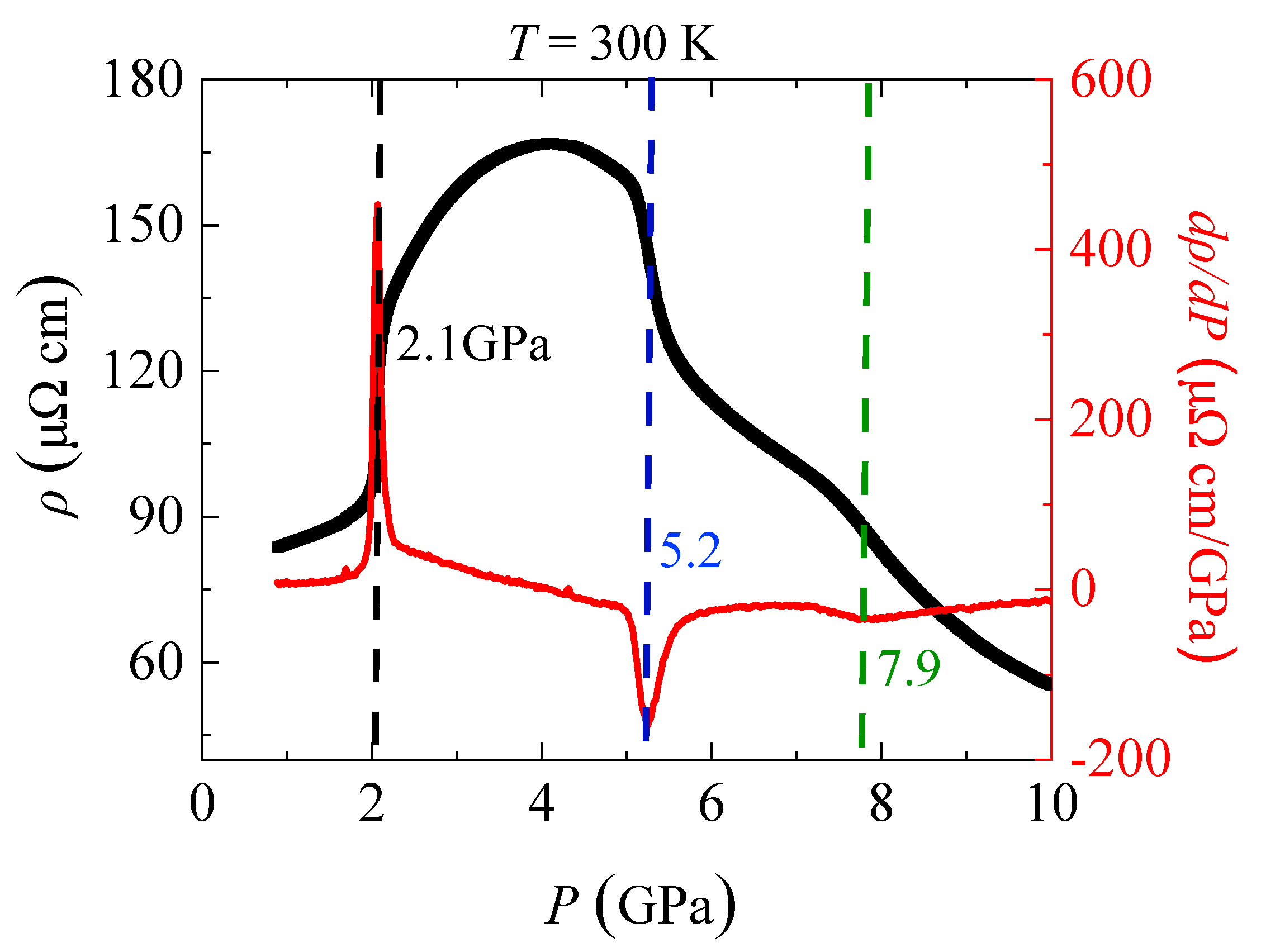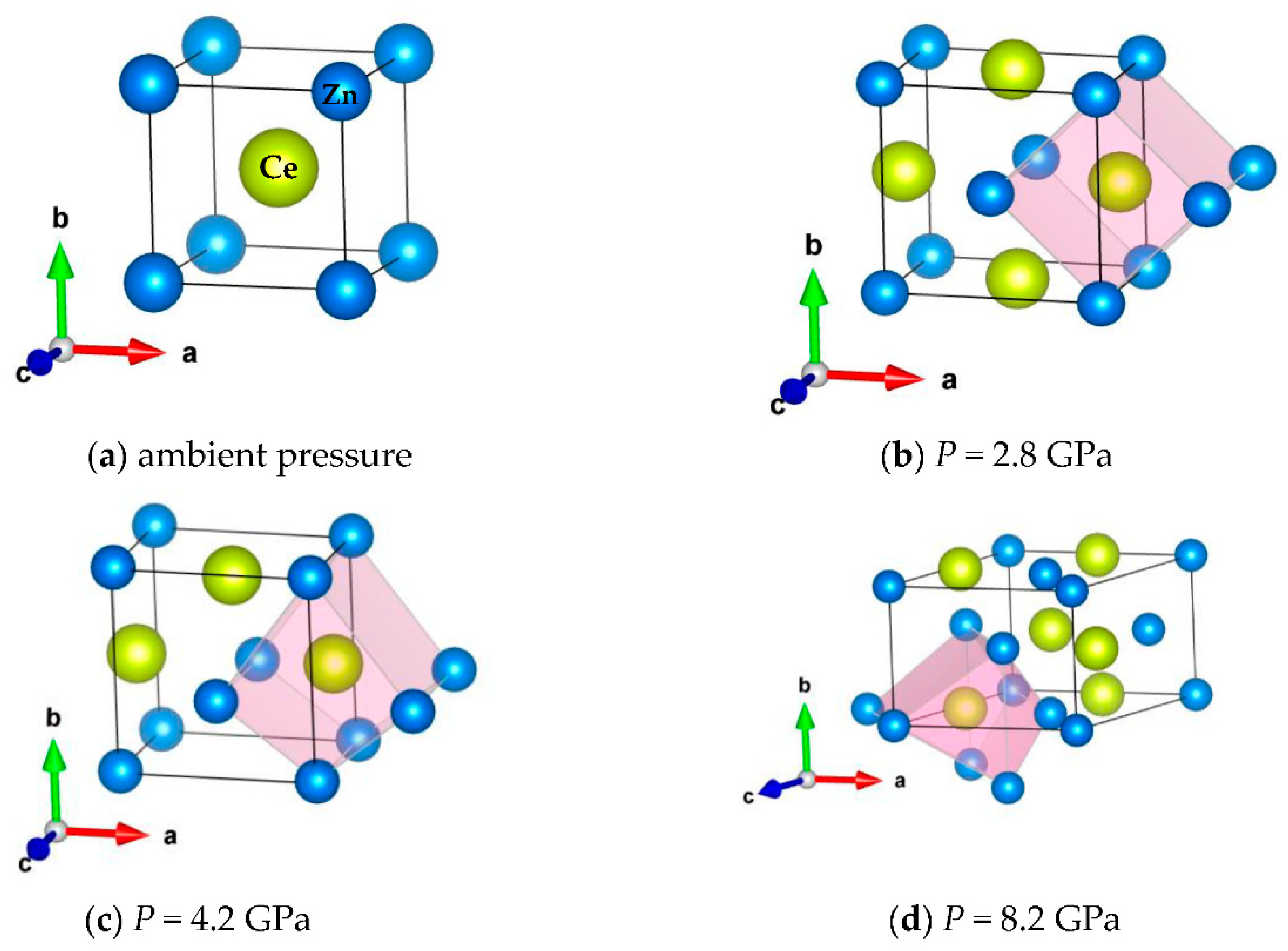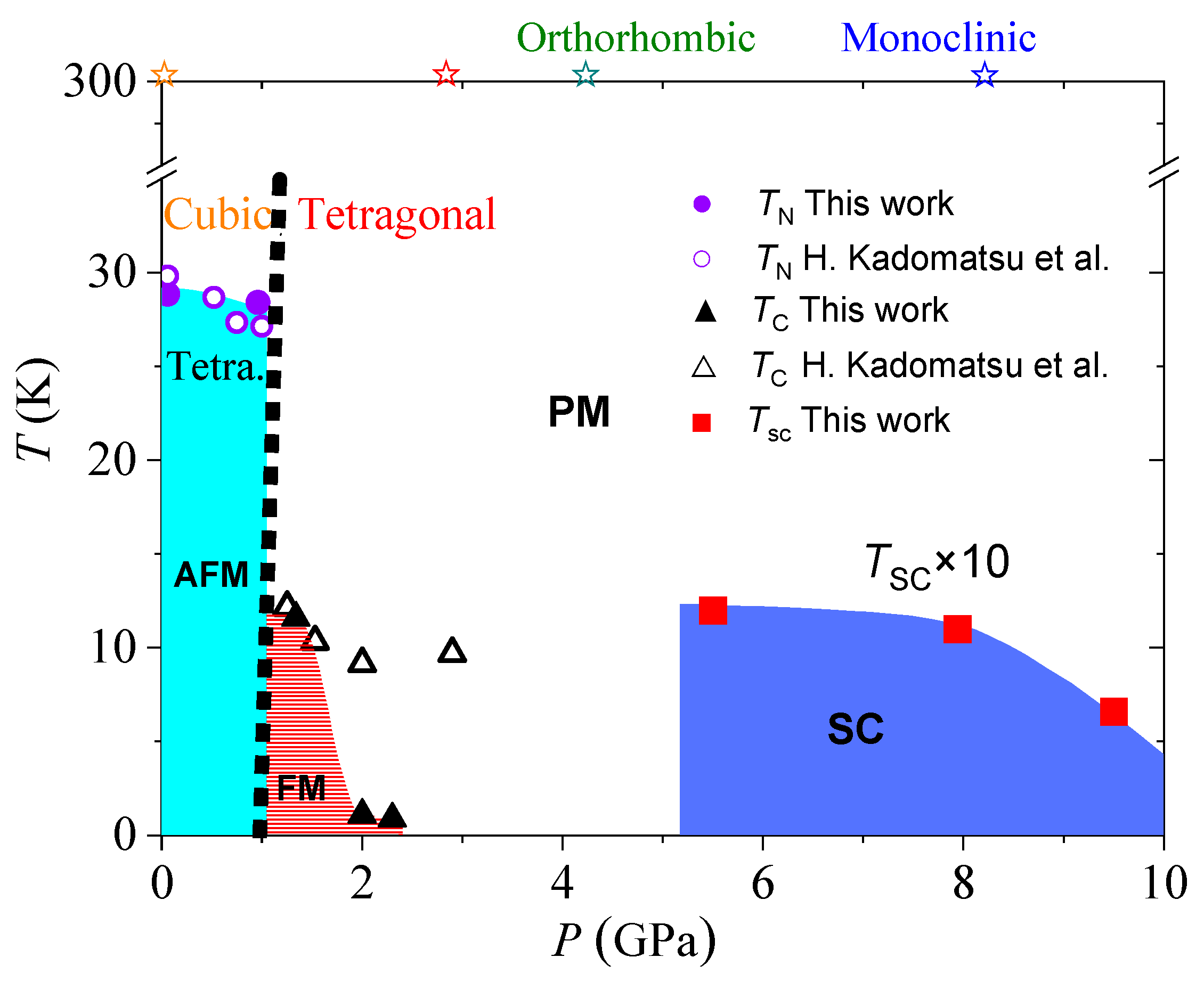Pressure Induced Superconductivity and Multiple Structural Transitions in CsCl-Type Cubic CeZn Single Crystal
Abstract
:1. Introduction
2. Single Crystal Growth and Experimental Technique
3. Results and Discussion
3.1. Electrical Resistivity under Pressure
3.2. Crystal Structural Transition under Pressure
3.3. Pressure-Temperature Phase Diagram
Author Contributions
Funding
Institutional Review Board Statement
Informed Consent Statement
Data Availability Statement
Acknowledgments
Conflicts of Interest
References
- Kurisu, M.; Kadomatsu, H.; Fujiwara, H. Magnetic and structural properties of CeAg at high pressure. J. Phys. Soc. Jpn. 1983, 52, 4349–4355. [Google Scholar] [CrossRef]
- Cornelius, A.L.; Gangopadhyay, A.K.; Schilling, J.S.; Assmus, W. Hydrostatic high-pressure studies on the ferromagnetic Kondo-lattice compounds CePdSb and CeAg to 16 GPa. Phys. Rev. B 1997, 55, 14109. [Google Scholar] [CrossRef]
- Kurisu, M.; Tanaka, H.; Kadomatsu, H.; Sekizawa, K.; Fujiwara, H. Magnetic and Structural Properties of CeTl at Hydrostatic Pressure. J. Phys. Soc. Jpn. 1985, 54, 3548–3553. [Google Scholar] [CrossRef]
- Kadomatsu, H.; Kurisu, M.; Kitai, T.; Okamoto, T.; Fujiwara, H. Magnetic and structural phase transition of CeCd at hydrostatic pressure. Phys. Lett. A 1983, 94, 178–180. [Google Scholar] [CrossRef]
- Kadomatsu, H.; Kurisu, M.; Fujiwara, H. Magnetic and structural properties of PrAg at high pressure. J. Phys. Soc. Jpn. 1984, 53, 1819–1827. [Google Scholar] [CrossRef]
- Peukert, H.; Schilling, J.S. Effect of hydrostatic pressure on phase transition and superconductivity in LaAgxIn1− x, LaCd and LaZn. Z. Für Phys. B Condens. Matter 1981, 41, 217–222. [Google Scholar] [CrossRef]
- Ihrig, H.; Vigren, D.T.; Kübler, J.; Methfessel, S. Cubic-to-Tetragonal Transformation and Susceptibility in LaAgx In1− xAlloys. Phys. Rev. B 1973, 8, 4525. [Google Scholar] [CrossRef]
- Asano, S.; Ishida, S. Band Jahn-Teller Effect in LaCd. J. Phys. Soc. Jpn. 1985, 54, 4241–4245. [Google Scholar] [CrossRef]
- Kadomatsu, H.; Tanaka, H.; Kurisu, M.; Fujiwara, H. Kondo state and pressure-induced ferromagnetism in CeZn. Phys. Rev. B 1986, 33, 4799. [Google Scholar] [CrossRef]
- Schmitt, D.; Morin, P.; Pierre, J. Magnetic structure and crystal field in cerium compounds with CsCl-type structure. J. Magn. Magn. Mater. 1978, 8, 249–256. [Google Scholar] [CrossRef]
- Pierre, J.; Murani, A.P.; Galera, R.M. Magnetic susceptibility, electrical resistivity and neutron spectroscopy of some cubic cerium intermetallics. J. Phys. F Met. Phys. 1981, 11, 679. [Google Scholar] [CrossRef]
- Shigeoka, T.; Uwatoko, Y.; Fujii, H.; Rebelsky, L.; Shapiro, S.M.; Asai, K. Pressure-induced structural and magnetic phase transitions in CeZn. Phys. Rev. B 1990, 42, 8394. [Google Scholar] [CrossRef] [PubMed]
- Uwatoko, Y.; Fujii, H.; Nishi, M.; Motoya, K.; Ito, Y. Neutron diffraction and magnetic studies of CeZn1− xCux single crystals. J. Magn. Magn. Mater. 1988, 76, 411–412. [Google Scholar] [CrossRef]
- Uwatoko, Y.; Fujii, H.; Nishi, M.; Motoya, K.; Ito, Y. A new crystallographic phase transition in the CsCl-type CeZn1− xCux compounds. Solid State Commun. 1989, 72, 941–943. [Google Scholar] [CrossRef]
- Uwatoko, Y.; Suenaga, K.; Oomi, G. X-ray diffraction study of the structural change in CeZn under high pressure. J. Magn. Magn. Mater. 1992, 104, 645–646. [Google Scholar] [CrossRef]
- Cheng, J.G.; Matsubayashi, K.; Nagasaki, S.; Hisada, A.; Hirayama, T.; Hedo, M.; Uwatoko, Y. Integrated-fin gasket for palm cubic-anvil high pressure apparatus. Rev. Sci. Instrum. 2014, 85, 093907. [Google Scholar] [CrossRef]
- Mori, N.; Takahashi, H.; Takeshita, N. Low-temperature and high-pressure apparatus developed at ISSP, University of Tokyo. High Press. Res. 2004, 24, 225–232. [Google Scholar] [CrossRef]
- Sidorov, V.A.; Sadykov, R.A. Hydrostatic limits of Fluorinert liquids used for neutron and transport studies at high pressure. J. Phys. Condens. Matter 2005, 17, S3005. [Google Scholar] [CrossRef]
- Torikachvili, M.S.; Kim, S.K.; Colombier, E.; Bud’Ko, S.L.; Canfield, P.C. Solidification and loss of hydrostaticity in liquid media used for pressure measurements. Rev. Sci. Instrum. 2015, 86, 123904. [Google Scholar] [CrossRef] [Green Version]
- Mao, H.K.; Xu, J.A.; Bell, P.M. Calibration of the ruby pressure gauge to 800 kbar under quasi-hydrostatic conditions. J. Geophys. Res. Solid Earth 1986, 91, 4673–4676. [Google Scholar] [CrossRef]
- Sheldrick, G.M. SHELXT–Integrated space-group and crystal-structure determination. Acta Crystallogr. Sect. A Found. Adv. 2015, 71, 3–8. [Google Scholar] [CrossRef] [PubMed] [Green Version]
- Sheldrick, G.M. Crystal structure refinement with SHELXL. Acta Crystallogr. Sect. C Struct. Chem. 2015, 71, 3–8. [Google Scholar] [CrossRef] [PubMed]
- Dolomanov, O.V.; Bourhis, L.J.; Gildea, R.J.; Howard, J.A.; Puschmann, H. OLEX2: A complete structure solution, refinement and analysis program. J. Appl. Crystallogr. 2009, 42, 339–341. [Google Scholar] [CrossRef]
- Jaccard, D.; Behnia, K.; Sierro, J. Pressure induced heavy fermion superconductivity of CeCu2Ge2. Phys. Lett. A 1992, 163, 475–480. [Google Scholar] [CrossRef]
- Vargoz, E.; Jaccard, D.; Genoud, J.Y.; Brison, J.P.; Flouquet, J. Upper critical field of CeCu2Si2 at very high pressure. Solid State Commun. 1998, 106, 631–636. [Google Scholar] [CrossRef]
- Grosche, F.M.; Walker, I.R.; Julian, S.R.; Mathur, N.D.; Freye, D.M.; Steiner, M.J.; Lonzarich, G.G. Superconductivity on the threshold of magnetism in CePd2Si2 and CeIn3. J. Phys. Condens. Matter 2001, 13, 2845. [Google Scholar] [CrossRef] [Green Version]
- Demuer, A.; Jaccard, D.; Sheikin, I.; Raymond, S.; Salce, B.; Thomasson, J.; Flouquet, J. Further pressure studies around the magnetic instability of CePd2Si2. J. Phys. Condens. Matter 2001, 13, 9335. [Google Scholar] [CrossRef]
- Walker, I.R.; Grosche, F.M.; Freye, D.M.; Lonzarich, G.G. The normal and superconducting states of CeIn3 near the border of antiferromagnetic order. Phys. C Supercond. 1997, 282, 303–306. [Google Scholar] [CrossRef]
- Knebel, G.; Braithwaite, D.; Canfield, P.C.; Lapertot, G.; Flouquet, J. Electronic properties of CeIn3 under high pressure near the quantum critical point. Phys. Rev. B 2001, 65, 024425. [Google Scholar] [CrossRef]
- Hegger, H.; Petrovic, C.; Moshopoulou, E.G.; Hundley, M.F.; Sarrao, J.L.; Fisk, Z.; Thompson, J.D. Pressure-induced superconductivity in quasi-2D CeRhIn5. Phys. Rev. Lett. 2000, 84, 4986. [Google Scholar] [CrossRef] [Green Version]
- Rueff, J.P.; Raymond, S.; Taguchi, M.; Sikora, M.; Itié, J.P.; Baudelet, F.; Jaccard, D. Pressure-induced valence crossover in superconducting CeCu2Si2. Phys. Rev. Lett. 2011, 106, 186405. [Google Scholar] [CrossRef] [PubMed]




| Pressure (GPa) | 0 | 2.8 | 4.2 | 8.2 |
|---|---|---|---|---|
| Crystal System | Cubic | Tetragonal | Orthorhombic | Monoclinic |
| Space Group | P4/nmm | Pma2 | P21/m | |
| a/Å | 3.7034(10) | 5.113(2) | 4.966(13) | 6.190(3) |
| b/Å | 3.7034(10) | 5.113(2) | 5.157(6) | 4.659(7) |
| c/Å | 3.7034(10) | 3.623(12) | 3.548(19) | 6.200(5) |
| 90 | 90 | 90 | 90 | |
| 90 | 90 | 90 | 113.66(8) | |
| 90 | 90 | 90 | 90 | |
| V/Å3 | 50.793(4) | 94.7(3) | 90.8(3) | 163.8(3) |
| D (g·cm−3) | 6.718 | 7.207 | 7.512 | 8.334 |
| Z | 1 | 2 | 2 | 4 |
| Measured Refl. | 1143 | 398 | 311 | 559 |
| Independent Refl. | 33 | 37 | 103 | 143 |
| Reflections with I > 2(I) | 33 | 35 | 88 | 116 |
| Rint (%) | 5.51 | 9.64 | 4.49 | 7.36 |
| GooF | 1.107 | 1.312 | 1.285 | 1.330 |
Publisher’s Note: MDPI stays neutral with regard to jurisdictional claims in published maps and institutional affiliations. |
© 2022 by the authors. Licensee MDPI, Basel, Switzerland. This article is an open access article distributed under the terms and conditions of the Creative Commons Attribution (CC BY) license (https://creativecommons.org/licenses/by/4.0/).
Share and Cite
Shen, X.; Ma, H.; Bhoi, D.; Gouchi, J.; Uwatoko, Y.; Dalan, A.; Kawamura, Y.; Sato, H.; Umehara, I.; Uehara, M. Pressure Induced Superconductivity and Multiple Structural Transitions in CsCl-Type Cubic CeZn Single Crystal. Crystals 2022, 12, 571. https://doi.org/10.3390/cryst12050571
Shen X, Ma H, Bhoi D, Gouchi J, Uwatoko Y, Dalan A, Kawamura Y, Sato H, Umehara I, Uehara M. Pressure Induced Superconductivity and Multiple Structural Transitions in CsCl-Type Cubic CeZn Single Crystal. Crystals. 2022; 12(5):571. https://doi.org/10.3390/cryst12050571
Chicago/Turabian StyleShen, Xiaoling, Hanming Ma, Dilip Bhoi, Jun Gouchi, Yoshiya Uwatoko, Alisha Dalan, Yukihiro Kawamura, Hiroyasu Sato, Izuru Umehara, and Masatomo Uehara. 2022. "Pressure Induced Superconductivity and Multiple Structural Transitions in CsCl-Type Cubic CeZn Single Crystal" Crystals 12, no. 5: 571. https://doi.org/10.3390/cryst12050571
APA StyleShen, X., Ma, H., Bhoi, D., Gouchi, J., Uwatoko, Y., Dalan, A., Kawamura, Y., Sato, H., Umehara, I., & Uehara, M. (2022). Pressure Induced Superconductivity and Multiple Structural Transitions in CsCl-Type Cubic CeZn Single Crystal. Crystals, 12(5), 571. https://doi.org/10.3390/cryst12050571






